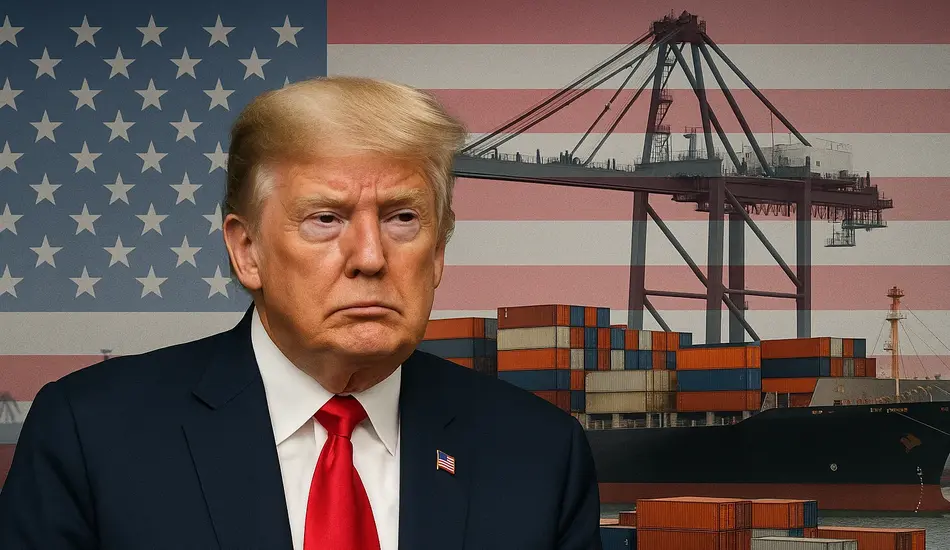President Trump is touting new tariffs as a historic opportunity to shrink the federal deficit. According to fresh analysis by the nonpartisan Congressional Budget Office (CBO), the tariffs could reduce U.S. debt by more than $4 trillion over the next decade. But behind the optimistic headlines, economists and small business owners warn the math only works because Americans themselves will foot the bill.
A $4 Trillion Deficit Cut — At What Cost?
The CBO report projects that tariffs on imports will raise roughly $400 billion annually through 2035, providing a significant new revenue stream for the federal government. Trump framed the move as a “windfall” for the U.S. economy, portraying the tariffs as a tool that both punishes foreign competitors and benefits American taxpayers.
But economists say the framing is misleading. “It’s not a windfall. It’s a tax,” explained Justin Wolfers, a professor of economics and public policy at the University of Michigan.
Wolfers outlined the process: when an American company such as Best Buy imports a washing machine from South Korea, the product cannot leave customs until the company writes a check covering the tariff. “At the first level, it’s U.S. firms paying the tax. Eventually, those costs get passed along to consumers in the form of higher prices,” he said.
According to Wolfers, data already shows that foreign suppliers are not reducing their prices to offset tariffs. “The import price index hasn’t fallen a penny,” he said. “That means the claim that foreign companies are paying is false. Right now, Americans are paying — either through lower corporate profits that affect investments and pensions, or through higher retail prices.”
Need to Hire Fast?
Post your job on WhatJobs and reach thousands of candidates today.
Post a Job Now →A Shift in the Tax Burden
Trump has pitched tariffs as a patriotic way to rebalance trade while strengthening U.S. finances. But Wolfers argues they are simply a sales tax on imported goods, one that hits everyday Americans harder than wealthy households.
“Essentially we’ve swapped one set of taxes for another,” he said. “The U.S. reduced income taxes for high earners in recent years. To plug the hole, tariffs are being used. Unlike income taxes, tariffs apply to everyone, because all of us buy imported products. The burden shifts from the rich to the working and middle class.”
For a household buying electronics, clothing, or kitchen appliances, the extra costs can add up quickly. Economists stress that the $4 trillion deficit reduction figure is only possible because millions of families will absorb higher prices over time.
Will Consumers See Rebate Checks?
During previous tariff debates, Trump floated the idea of issuing rebate checks to consumers, effectively redistributing tariff revenue back to households. Treasury Secretary officials have since poured cold water on that idea, emphasizing deficit reduction as the primary focus.
Wolfers dismissed the rebate concept as unrealistic. “We were told in the past that trillions in savings from tariffs would mean rebate checks for Americans,” he said. “But those savings never materialized. And with the current budget, that money has already been allocated elsewhere — largely to fund tax cuts for wealthier households.”
Instead, the federal government is likely to treat tariffs as a stable revenue stream, similar to income or payroll taxes. “At the end of the day, it’s not a gift. It’s a new tax collection mechanism,” Wolfers said.
Small Businesses Face the Squeeze
For U.S. businesses that rely on imported goods, tariffs have become a day-to-day operational challenge.
Fontana Forni USA, a distributor of high-end Italian outdoor pizza ovens, illustrates the strain. The company imports ovens directly from a family-owned manufacturer in Italy, and CEO Jeremy Lande says tariffs have upended his business model.
“In June, we had two ocean containers taxed at over 80%,” Lande explained. “It ties up huge amounts of cash and makes it nearly impossible to plan inventory levels.”
Lande said the company initially tried to absorb the added costs, but eventually had to raise prices. On August 1, Fontana Forni implemented its first price increase in years — a 10% hike. “We didn’t take that decision lightly. But to maintain product quality, there was no other option,” he said.
The uncertainty, Lande added, is almost as damaging as the tariffs themselves. “Even customs brokers don’t always know how to apply the rules. If there were clear guidance and predictability, we could at least plan. But the constant shifts are really disruptive.”
The Double Tariff Effect
Businesses like Fontana Forni face not just one tariff, but multiple layers. Imported ovens are subject to the standard 15% EU tariff, but the steel used in manufacturing triggers an additional 50% steel tariff. The combined effect pushes costs far beyond what most small businesses can reasonably absorb.
“We’re already operating on the best possible terms with our Italian supplier,” Lande said. “There’s no wiggle room there. So ultimately the only place those costs can go is into higher prices for American consumers.”
Tariffs as a Political Tool
While Trump emphasizes deficit reduction, tariffs also serve as a political signal. They allow the administration to showcase toughness on trade while generating revenue without formally raising income taxes.
Critics argue the policy is short-sighted. By making imports more expensive, tariffs encourage U.S. consumers to pay more without guaranteeing that domestic production ramps up in response. “If tariffs change before new factories are built, companies won’t invest,” Wolfers noted. “The instability undermines the very purpose of the policy.”
Supporters counter that tariffs provide leverage in trade negotiations, forcing other countries to adjust policies or increase purchases of U.S. goods.
Need to Hire Fast?
Post your job on WhatJobs and reach thousands of candidates today.
Post a Job Now →The Consumer Impact
For now, the practical impact is showing up in higher prices at checkout. From appliances to specialty items like pizza ovens, companies are gradually passing along costs.
Wolfers said the transition is unavoidable. “Initially businesses like Best Buy or Fontana Forni try to absorb the tariffs. But sooner or later, margins shrink too much, and they’re forced to raise prices. The longer tariffs stay in place, the more Americans will feel it directly.”
Looking Ahead
The CBO’s $4 trillion projection assumes tariffs remain in place through 2035. Economists are skeptical. “Close to no chance,” Wolfers said bluntly. “Tariffs are politically volatile. Businesses can’t make decade-long investment decisions based on policies that might change after the next election cycle.”
Still, even short-term tariffs are reshaping supply chains and straining small businesses. Lande warned that uncertainty could drive companies to cut back on imports altogether. “Without transparency and predictability, it’s hard to grow,” he said.
FAQs
1. Who actually pays tariffs — foreign companies or Americans?
Tariffs are paid by U.S. companies when goods arrive at customs. These businesses either absorb the costs (reducing profits) or pass them along to consumers through higher prices.
2. Will Americans receive rebate checks from tariff revenue?
Unlikely. While Trump floated the idea in the past, Treasury officials emphasize deficit reduction. Economists say most of the projected $400 billion per year is already factored into federal budgets.
3. How much do tariffs reduce the deficit?
The CBO estimates $4 trillion over ten years, or about $400 billion annually. Critics argue this represents a tax shift, moving the burden from wealthy individuals to middle-class consumers.
4. How do tariffs affect small businesses?
Importers face immediate cash strains and long-term uncertainty. Fontana Forni USA, for example, faced an effective 80% tariff on some shipments, forcing price hikes. Many small firms say unpredictability is their biggest obstacle.




